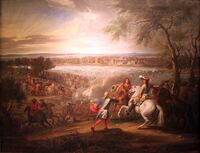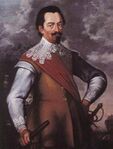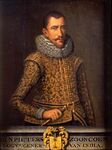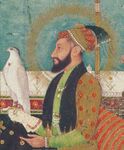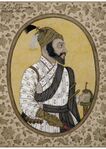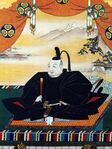قرن 17
القرن السابع عشر هو الفترة الزمنية الممتدة من اليوم الأول لعام 1601 إلى اليوم الأخير من عام 1700 حسب التقويم الميلادي.
| الألفية: | الألفية 2 |
|---|---|
| القرون: | |
| خطوط زمنية: | |
| زعماء الدول: |
|
| العقود: | |
| التصنيفات: | المواليد – الوفيات التأسيسات – الانحلالات |
شهد هذا القرن صراع الإمبراطوريات علي انشاء مستعمرات في أمريكا وجزر الهند الشرقية للتجارة
شهدت بداية هذا القرن انتصار الدولة الصفوية علي الدولة العثمانية واستردوا أذربيجان وكردستان والموصل وبغداد .
شهد أيضا حرب الثلاثين عاما التي بدأت بالثورة البوهيمية باعتراض البروتستانت علي تعيين الكاثوليكي المتعصب فرديناند الثاني وليا العهد للامبراطور الروماني المقدس ماثياس وانضم لهم نبلاء النمسا ثم تدخلت دول اوروبا حيث دعمت اسبانيا هابسبورغ علي الجانب الأخر تدخلت الدنمارك والسويد وأخيرا فرنسا. انتهت حرب الثلاثين عاما بصلح وستفاليا بعد هزيمة هابسبورگ وانتصار السويديين والفرنسيين واعلان استقلال سويسرا وهولاندا.
شهد ايضا اندلاع الحرب الأهلية الإنجليزية بين أنصار تشارلز الأول ملك إنجلترا من جهة وجيش البرلمانيين والأسكتلنديين من جهة. وبعد هزيمة الملكيين اسس أوليفر كرومويل كومنولث إنجلترا الحر. ولكن بعد عشر سنوات تم استعادة الحكم الملكي بعد وفاة كرومويل.
شهد ايضا اندلاع الحروب الإنجليزية الهولندية للسيطرة علي البحار والمستعمرات.
تلقي العثمانيين في نهاية هذا القرن هزائم منكرة وأجبرت على توقيع معاهدة كارلوفجة تنازل فيها العثمانيون عن معظم أراضي المجر وترانسلفانيا وسلاڤونيا للنمسا في حين عادت بودوليا إلى بولندا ودالماتيا والمورة لجمهورية البندقية.
في اليابان نهاية فترة أزوتشي موموياما وبداية فترة إدو. أما في الصين فقد تمكن نورحاجي من توحيد قبائل جورشن وشن هجوماً على أسرة مينگ في الصين حتي استطاع القضاء عليها وتأسيس أسرة تشينگ [1][2][3]
From the mid-17th century, European politics were increasingly dominated by the Kingdom of France of Louis XIV, where royal power was solidified domestically in the civil war of the Fronde. The semi-feudal territorial French nobility was weakened and subjugated to the power of an absolute monarchy through the reinvention of the Palace of Versailles from a hunting lodge to a gilded prison, in which a greatly expanded royal court could be more easily kept under surveillance. With domestic peace assured, Louis XIV caused the borders of France to be expanded. It was during this century that the English monarch became a symbolic figurehead and Parliament was the dominant force in government – a contrast to most of Europe, in particular France.
By the end of the century, Europeans were aware of logarithms, electricity, the telescope and microscope, calculus, universal gravitation, Newton's Laws of Motion, air pressure, and calculating machines due to the work of the first scientists of the Scientific Revolution, including Galileo Galilei, Johannes Kepler, René Descartes, Pierre Fermat, Blaise Pascal, Robert Boyle, Christiaan Huygens, Antonie van Leeuwenhoek, Robert Hooke, Isaac Newton, and Gottfried Wilhelm Leibniz. It was also a period of development of culture in general (especially theater, music, visual arts and philosophy).
It was during this period that the European colonization of the Americas began in earnest, including the exploitation of the silver deposits, which resulted in bouts of inflation as wealth was drawn into Europe.[4] Also during this period, there would be a more intense European presence in Southeast Asia and East Asia (such as the colonization of Taiwan). These foreign elements would contribute to a revolution in Ayutthaya. While the Mataram Sultanate and the Aceh Sultanate would be the major powers of the region, especially during the first half of the century.
In the Islamic world, the gunpowder empires – the Ottoman, Safavid, and Mughal – grew in strength. Especially in the Indian subcontinent, Mughal architecture, culture, and art reached its zenith, while the empire itself, during the reign of Emperor Aurangzeb, is believed to have had the world's largest economy, bigger than the entirety of Western Europe and worth 25% of global GDP.[5] The southern half of India would see the decline of the Deccan Sultanates and extinction of the Vijayanagara Empire. The Dutch would colonize Ceylon and endure hostilities with Kandy.

In Japan, Tokugawa Ieyasu established the Tokugawa shogunate at the beginning of the century, beginning the Edo period; the isolationist Sakoku policy began in the 1630s and lasted until the 19th century. In China, the collapsing Ming dynasty was challenged by a series of conquests led by the Manchu warlord Nurhaci, which were consolidated by his son Hong Taiji and finally consummated by his grandson, the Shunzhi Emperor, founder of the Qing dynasty.
The greatest military conflicts of the century were the Thirty Years' War,[1] Dutch–Portuguese War, the Great Turkish War, the Nine Years' War, Mughal–Safavid Wars, and the Qing annexation of the Ming.
أحداث
1601–1650
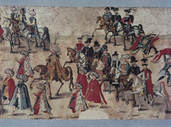
- 1600 تأسيس شركة الهند الشرقية البريطانية للتجارة مع جزر الهند الشرقية.
- 1601 أأنتهت معركة كينسال بأنتصار الجيش الانجليزي علي جيش المقاومة الايرلندية.
- 1602 تأسيس شركة الهند الشرقية الهولندية للتجارة مع جزر الهند الشرقية.
- 1603 نهاية فترة أزوتشي موموياما وبداية فترة إيدو في اليابان بعد سيطرة توكوجاوا إيياسو الذي أسس شوغونية توكوغاوا.
- 1603 وفاة السلطان العثماني محمد الثالث في ديسمبر وخلفه ابنه أحمد الأول الذي تميز بدايه عهده بالحروب والتمردات فعم الفساد والظلم وغزا الفرس العراق حتى تولي الصدر الاعظم مراد باشا القويوجي الذي نشر العدل وقضى على التمرد.
- 1603 وفاة إليزابيث الأولى ملكة إنجلترا وأيرلندا في مارس ولم يكن لها وريث انتقل الحكم إلى جيمس السادس ملك أسكتلندا وابن ماري ملكة اسكتلندا الذي أصبح جيمس الأول ملك إنجلترا وايرلندا واسكتلندا وبالتالي أول ملك لانجلترا من آل ستيوارت.
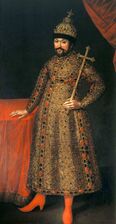
- 1605 وفاة قيصر عموم روسيا بوريس غودونوف في ابريل حيث عمت روسيا حالة من الفوضى فأعلن سييسموند فاسا ملك بولندا ترشيح نفسه للعرش المسكوفي وسار بجيش إلى روسيا لكن الطقس السيئ حال بينه وبين الوصول لموسكو بالاضافة لتمرد جنوده مما اضطره للعودة خائبا.
- 1605 تمكن الشاه عباس الأول الصفوي من الانتصار علي العثمانيين واسترد أذربيجان وكردستان والموصل وبغداد.
- 1606 بدأ الإستيطان الانجليزي في أمريكا عندما أعطى جيمس الأول ملك إنجلترا إحدى الشركات الحق بإقامة مستوطنة فجهزت ثلاث سفن محملة بالجنود المسرحين والمغامرين فوصلت إلى ساحل فرجينيا.
- 1606 طلب ماثياس من اخيه الإمبراطور الروماني رودولف الثاني المريض السماح له بالتعامل مع المتمردين المجريين البروتستانت. وكانت النتيجة هي معاهدة فيينا والتي تضمنت الحرية الدينية في المجر.
- 1606 تولي ماثياس حكم المجر وكرواتيا وبوهيميا لاحقا من قبل اخيه الإمبراطور الروماني رودولف الثاني.
- 1610 أغتيل هنري الرابع ملك فرنسا علي يد راهب فرنسي مجنون في مابو وخلفه ابنه لويس الثالث عشر ملك فرنسا
- 1611 أعلن كريستيان الرابع ملك الدنمارك والنرويج الحرب علي السويد وشرع في غزو السويد.
- 1611 وفاة كارل التاسع ملك السويد وخلفه ابنه غوستاف الثاني أدولف الذي عقد صلحا مع الدنمارك ليتفرغ لحربه مع سييسموند فاسا ملك بولندا المطالب بعرش السويد.
- 1612 وفاة الإمبراطور الروماني رودولف الثاني في يناير وخلفه اخية ماثياس الثاني.
- 1613: The Time of Troubles in Russia ends with the establishment of the House of Romanov, which rules until 1917.
- 1613–1617: Polish–Lithuanian Commonwealth is invaded by the Tatars dozens of times.[6]
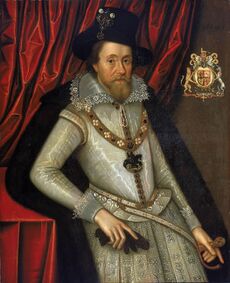 James I of England and VI of Scotland ruled in the first quarter of the 17th century
James I of England and VI of Scotland ruled in the first quarter of the 17th century - 1613: The Dutch East India Company is forced to evacuate Gresik due to the Mataram siege in neighboring Surabaya. The dutch negotiates with Mataram and is allowed to set up a trading post in Jepara.
- 1614–1615: The Siege of Osaka (last major threat to Tokugawa shogunate) ends.
- 1614 أنتخب مجلس زيمسكي (مؤتمر ممثلي فئات الشعب) ميخايل رومانوف قيصر عموم روسيا الذي يعتبر مؤسس عائلة رومانوف التي استمرت في الحكم حتي 1917م.
- 1614 تأسيس شركة الهند الشرقية الدنماركية للتجارة مع الهند.
- 1617 عقد غوستاف الثاني أدولف ملك السويد صلحا مع قيصر عموم روسيا ميخايل رومانوف أعترفت فيه روسيا بسيادة السويد علي ليفونيا وأستونيا.
- 1617 وفاة االسلطان العثماني أحمد الأول في نوفمبر وخلفه اخيه مصطفى الأول الذي كان غير قادرا علي ادارة شؤن الدولة فعزل بعد ثلاث اشهر وتولي ابن اخيه عثمان الثاني.
- 1618 أعلن السلطان العثماني عثمان الثاني الحرب علي بولندا لتدخلها في شؤن البغدان (مولدوفا) ودعم القوزاق كان عثمان يطمح في غزو بولندا والوصول لبحر البلطيق لتطويق النمسا من الشرق والجنوب ولكنه فشل واضطر لعقد معاهدة بعد موافقة بولندا علي عدم تدخلها في شؤن البغدان.
- 1618 بدأت حرب الثلاثين عاما بالثورة البوهيمية عندما اراد الإمبراطور الروماني ماثياس الذي كان بدون وريث تأمين تمرير انتقال للسلطة لاحد افراد عائلة آل هابسبورغ فاختار ابن عمه الكاثوليكي المتعصب فرديناند ولياً للعهد فأشتعلت الثورة في بوهيميا ذات الاغلبية البروتستانتية.
- 1619 وفاة الامبراطور الروماني ماثياس في مارس وخلفه فرديناند الثاني (إمبراطور روماني مقدس). فانتفض البوهيميين الذين رجحت كفتهم عند بداية التمرد وانضم لثورتهم الكثير من نبلاء النمسا العليا اللوثرييين والكلفنيين.
- 1619 وقعت النمسا العليا والسفلى التي ما زالت تحت سيطرة الثوار تحالفا مع البوهيميين الذين عزلوا الإمبراطور الروماني فرديناند الثاني رسمياُ عن عرش بوهيميا ونصبوا فريدريك الخامس (ناخب بالاتينات).
- 1620 في المجر استمر الترانسلفانيون في إحراز تقدم ونجحوا في طرد جيش الإمبراطور الروماني فرديناند الثاني.
- 1620–1621: Polish–Ottoman War over Moldavia.
- 1620: Bethlen Gabor allies with the Ottomans and an invasion of Moldavia takes place. The Polish suffer a disaster at Cecora on the River Prut.
- 1620: The Mayflower sets sail from Plymouth, England to what became the Plymouth Colony in New England.
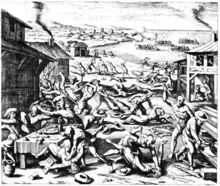 The 1622 massacre was instrumental in causing English colonists to view all natives as enemies
The 1622 massacre was instrumental in causing English colonists to view all natives as enemies - 1621: The Battle of Chocim: Poles and Cossacks under Jan Karol Chodkiewicz defeat the Ottomans.
- 1621 وفاة فيليب الثالث ملك إسبانيا في مارس وخلفه ابنه فيليب الرابع ملك إسبانيا الذي لبي طلب عمه الإمبراطور الروماني فرديناند الثاني وارسل جيشا اسبانيا لمواجهه الثوار البروتستانت.
- 1621 حقق الإمبراطور الروماني فرديناند الثاني انتصار حاسما على فريدريك الخامس (ناخب بالاتينات) في معركة الجبل الأبيض بالقرب من براغ أدت هذه الهزيمة إلى انحلال رابطة الإتحاد الإنجيلي. وفقدان فريدريك الخامس لأملاكه بعد ان جردته الإمبراطورية من حقوقه وأعطيت أراضيه في بالاتينات لنبلاء كاثوليك وأعطي لقبه ناخب بالاتينات لابن عمه دوق بافاريا.
- 1621 أنتهت المرحلة الأولى من حرب الثلاثين عاما في شرق ألمانيا بتوقيع صلح منح ترانسلفانيا بعض من اراضي المجر وهزيمة ساحقة للبروتستانت دفعت بقايا جيوش البروتستانت للهرب الي هولندا.
- 1621 قاد غوستاف الثاني أدولف ملك السويد جيشه عبر البلطيق واحتل ريفا البولندية وثبت سيطرته علي ليفونيا.
- 1622 أستولى الهولنديون على معظم مراكز التجارة البرتغالية الموجودة في الهند الشرقية وسيطروا علي تجارة البهارات المربحة مما ادي لامتلاك هولندا أكبر أسطول تجاري في أوربا وازدادت قوة البحرية الهولندية تدريجيا وإن كانت بمعدل أقل من أسطولها التجاري.
- 1622 ألقي السلطان العثماني عثمان الثاني باللوم علي الإنكشارية لعدم قدرة الجيش علي احتلال بولندا وشرع في اصلاحات جذرية في الجيش مما اغضب الانكشارية الذين انقلبوا عليه وقتلوه في مايو وتولي عمه السلطان مصطفى الأول مرة اخري.
- 1623 عزل السلطان العثماني مصطفى الأول وتولي ابن اخيه مراد الرابع في الحادي عشر من عمره فسيطر عليه الانكشارية في بداية ولايته اللتي تميزت بعدم الاستقرار حتي ثار عليه الإنكشارية فضرب بيد من حديد على الثائرين وقتل كل من ثبت أن له علاقة بالفتنة فاستقرت الأوضاع وبدأ السلطان في أعادة النظام إلى الدولة تمهيدا لاستعادة الاراضي اللتي فقدتها السلطنة.
- 1625 وفاة جيمس الأول ملك إنجلترا وإيرلندا وأسكتلندا في مارس وخلفه ابنه تشارلز الأول ملك إنجلترا الذي حل البرلمان وحاول الحكم منفردا ولكن انتفاضة الاسكتلنديين اجبرته علي اعادة البرلمان.
- 1625 خشية النجاحات الكاثوليكية في حرب الثلاثين عاما قرر كريستيان الرابع ملك الدنمارك والنرويج اللوثري ودوق هولشتاين الواقعة ضمن الإمبراطورية الرومانية المقدسة التدخل في حرب الثلاثين عاما.
- 1626 أحتل الجيش السويدي بروسيا الشرقية والغربية الخاضعتين للتاج البولندي.
- 1629 تراجع جيش الدنمارك امام الجيش الامبراطوري الذي احتل بوميرانا وبوتلند لكن لم يستطع احتلال كوبنهاجن واضطر كريستيان الرابع للتفاوض الذي انتهي بمعاهدة لوبيك التي نصت على احتفاظ كرستيان الرابع بسيطرته على الدنمارك شريطة تخليه عن دعم الامارات الألمانية البروتستانتية.
- 1629 أنتهت حرب السويد وبولندا بصلح التمارك بمقتضاه سيطرت السويد على ليفونيا وعلى البلطيق.
- 1630 خوفا من الطوفان الكاثوليكي قرر غوستاف الثاني أدولف ملك السويد التدخل في حرب الثلاثين عاما.
- 1631 أعتبرت السويد التقدم النمساوي في بوميرانا مثابة إعلان جديد للحرب لذا وثـّق التحالف مع فرنسا.
- 1632 أحتل الجيش السويدي ميونخ وماينتس فاعاد الجيش الامبراطوري تنظيم صفوفه وهاجم الجيش السويدي في معركة لوتسن ولكن النصر كان حليف السويد رغم وقوع ملك السويد غوستاف الثاني أدولف قتيلا في نوفمبر وخلفه في الحكم ابنته كرستينا ملكة السويد.
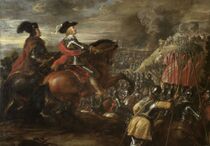
- 1632 وفاة سييسموند فاسا ملك بولندا في ابريل وخلفه ابنه فواديسواف الرابع فاسا الذي كان متسامحا مع البروتستانت في بولندا ونجح بفضل سياسته في بقاء بولندا بعيدة عن حرب الثلاثين عاما التي اجتاحت اوربا رغم كونه حليفا لآل هابسبورغ.
- 1634 تحركت إسبانيا لمواجهه التهديدات المتواصلة للسويد التي هددت بوهيميا والنمسا مركز أسرة هابسبورغ واحتلت ما يقرب من نصف ولايات الإمبراطورية الرومانية المقدسة.
- 1636 انزعج كريستيان الرابع ملك الدنمارك والنرويج من انتصارات السويد التي اصبحت سويدية اكثر منها بروتستانتية فقرر ان يتدخل لجانب النمسا البعيدة بدلا من السويد القريبة فأعلن الحرب علي السويد لكنه انهزم وتم غزو أراضيه مجددا مما أدى لترك الدانمارك الحرب.
- 1637 وفاة الامبراطور الروماني فرديناند الثاني في فبراير وخلفه ابنه فرديناند الثالث (إمبراطور روماني مقدس).
- 1639 اندلعت حروب الممالك الثلاث انجلترا وايرلندا واسكتلندا وهي حرب اهلية اندلعت بسبب فرض ممارسات انجليكانية علي الكنيسة الاسكتلندية واضطهاد الكاثوليك في ايرلندا.
- 1640–1668: The Portuguese Restoration War led to the end of the Iberian Union.
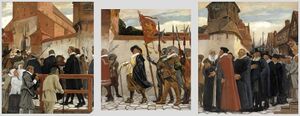 The inauguration of the Royal Academy of Turku in 1640.
The inauguration of the Royal Academy of Turku in 1640. - 1640 وفاة السلطان العثماني مراد الرابع في فبراير وخلفه اخيه إبراهيم الأول الضعيف ورغم الحالة السيئة التي كانت عليها أجهزة الدولة وتغلغل نفوذ نساء القصر فإن الدولة ظلت قوية فقامت بغزو جزيرة كريت وانتزاعها من ايدي جمهورية البندقية.
- 1643 وفاة لويس الثالث عشر ملك فرنسا في مايو وخلفه ابنه لويس الرابع عشر ملك فرنسا في الخامسة من عمره تحت وصاية الوزير الأول جول مازاران
- 1643 قرر جول مازاران الوصي علي ملك فرنسا التدخل في حرب الثلاثين عاما الي جانب البروتستانت في مواجهه آل هابسبورغ فعبر الجيش الفرنسي الراين ليشترك في النزاع وتلاحم مع الجيش الأسباني في روكروا حيث حطم الفرنسيين قوة مشاة الجيش الإسباني التي لا تقهر.
- 1644 تمكن نورهس من توحيد قبائل جورشن وشن هجوماً على سلالة مينغ الحاكمة في الصين حتي استطاع القضاء عليها وتأسيس سلالة تشينغ الحاكمة
- 1645 تمكن البروتستانت من الانتصار علي الجيش الامبراطوري في معركة يانكوف في بوهيميا.
- 1645 أندلعت الحرب الأهلية في انجلترا بين أنصار الملك تشارلز الأول ملك إنجلترا من جهة وجيش البرلمانيين والأسكتلنديين من جهة أخري حيث منيت القوات الملكية بهزيمة في نيزبي.
- 1648 أعلن صلح وستفاليا منهيا حرب الثلاثين عاما التي كانت ضحاياها ثلث سكان المانيا بهزيمة هابسبورغ وانتصار السويديين والفرنسيين.
- 1648 أهم بنود صلح وستفاليا: الأعتراف بأستقلال سويسرا وهولندا. ونالت فرنسا اراض وعشر مدن في الالزاس. ونالت السويد بوميرانا الغربية بالاضافة لبريمن وفيردن. قسمت البالاتينات بين شارل لويس أبن فريدريك الخامس ودوق بافاريا ماكسيميليان وبذلك قسمت بين البروتستانت والكاثوليك ولكل منهم صوت انتخابي. حصلت براندنبورج - بروسيا على بوميرانا الشرقية.
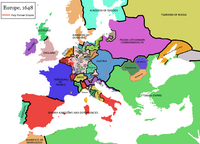
- 1648–1653: Fronde civil war in France.
- 1648 وفاة ملك بولندا فواديسواف الرابع فاسا في مايو وخلفه اخيه يان الثاني الذي فقدت بولندا في عهده الكثير من اراضيها في حروبها مع روسيا والسويد
- 1648 تدهورت احوال الدولة العثمانية واضطربت ماليتها ونزع الإنكشارية إلى التدخل في شئون الدولة حاول السلطان إبراهيم الأول أن يقمع الفتنة ويتخلص من زعماء الإنكشارية لكنهم علموا بنواياه فقتلوه في اغسطس وخلفه ابنه محمد الرابع وهو في السابعة من عمره تحت وصاية جدتة السلطانة كوسم.
- 1649 بعد انتصار البرلمانيين علي الملكيين في الحرب الأهلية الإنجليزية عقد قائد الثوار الانجليزي أوليفر كرومويل جلسة خاصة للبرلمان الذي أصدر حكم بإعدام تشارلز الأول ملك إنجلترا في يناير.
- 1650 وفاة حاكم الجمهورية الهولاندية وليم أورانج الثاني والغاء منصب الحاكم العام.
1651–1700
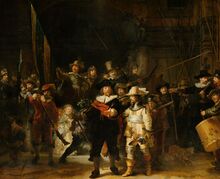
- 1651 - انتصار أوليفر كرومويل علي تشارلز ابن تشارلز الأول ملك إنجلترا السابق في معركة ووستر وهرب تشارلز إلى هولاندا ودخلت البلاد فترة انتقال السلطة.
- 1651 أصبح أوليفر كرومويل الحاكم الفعلى لانجلترا واسكتلندا وأيرلندا مؤسسا كومنولث إنجلترا الحر الذي اصبح رئيسه.
- 1652 أندلعت الحرب الإنجليزية الهولندية الأولى للسيطرة علي البحار وانتهت بانتصار البحرية الانجليزية وبداية بسط سيطرتها على البحار والتوسع في اقامة مستعمرات انجليزية في العالم الجديد .
- 1653 انتخاب يوهان دي فيت حاكم عام الجمهورية الهولاندية
- 1654 تخلت كرستينا ملكة السويد عن العرش بعد اعتناقها االكاثوليكية وخلفها كارل العاشر غوستاف الذي كان كونت بلاتينات الالمانية.
- 1654 وفاة قيصر عموم روسيا ميخايل رومانوف في يوليو وخلفه ابنه أليكس الأول الذي نقل بعض اختصاصاته الي مجلس الدوما.
- 1654 أندلعت ثورة القوزاق في اوكرانيا التابعة لبولندا واثروا تبعيتها لروسيا وبالفعل استولي الجيش الروسي علي اوكرانيا الشرقية بدعم القوزاق واصبح اقليم روسي بحكم ذاتي.
- 1655 بينما كان البولنديون يحاربون الروس في الجبهه الشرقية قاد كارل العاشر غوستاف ملك السويد جيشه إلى غرب بولندا واستولى على العاصمة وارسو واخضع الجيش البولندي والنبلاء الذين اقسموا يمين الولاء لملك السويد الا ان الجيش السويدي عاث في البلاد فساد من سلب ونهب مما اثار الشعب وخاصة الكاثوليك فانتفض وطرد الحامية السويدية واعاد الملك البولندي يان الثاني.
- 1655 وقعت روسيا هدنة مع بولندا مؤثرة جيرة بولندا علي جيرة السويد.
- 1657 وفاة الامبراطور الروماني فرديناند الثالث في ابريل وخلفه ابنه ليوبولد الأول (إمبراطور روماني مقدس)
- 1657 : Sambhaji, the second King of Maratha Empire and eldest son of King Shivaji was born at Purandar Fort on 14 May.[7]
- 1658: After his father Shah Jahan completes the Taj Mahal, his son Aurangzeb deposes him as ruler of the Mughal Empire.
- 1659: King Shivaji killed Adil Shahi dynasty's general Afzal Khan at Pratapgad fort on 9 November.[8]
- 1660: The Commonwealth of England ends and the monarchy is brought back during the English Restoration.
- 1660: The Royal Society is founded.
- 1661: The reign of the Kangxi Emperor of China begins.
- 1663: Ottoman war against Habsburg Hungary.
- 1664: The Battle of St. Gotthard: count Raimondo Montecuccoli defeats the Ottomans. The Peace of Vasvar – intended to keep the peace for 20 years.
- 1665: Maratha King Shivaji singed Treaty of Purandar with Mughal general Jai Singh I after Battle of Purandar.[7]
- 1665: Robert Hooke discovers cells using a microscope.
- 1665: Portugal defeats the Kongo Empire at the Battle of Mbwila.
- 1665–1667: The Second Anglo-Dutch War fought between England and the United Provinces.
- 1666: The Great Fire of London.
- 1666: Shivaji visited Aurangzeb at Agra Fort and forced him into house arrest. Shivaji later escaped and returned to the Maratha kingdom.[7]
- 1667 شنت هولندا هجومًا مفاجئًا على إنجلترا في ميدواي اغرقت معظم سفن الأسطول الانجليزي واسروا تشارلز الثاني ملك إنجلترا انتهت الحرب الإنجليزية الهولندية الثانية بتوقيع معاهدة بريدا.
- 1667 توقيع معاهدة أندروسوف بين بولندا وروسيا ونالت روسيا بمقتضى المعاهدة سمولينسك، وكييف وأوكرانيا الشرقية
- 1668 بعد انتصار البرتغال علي الاسبان بدعم فرنسي انجليزي انتهت حرب الاستعادة البرتغالية بمعاهدة لشبونة التي تقضي باعتراف اسبانيا باستقلال البرتغال مقابل تنازل البرتغال عن سبتة إلى التاج الأسباني وتتويج أفونسو السادس ملك البرتغال.
- 1669 تخلي الملك البولندي يان الثاني عن العرش وانتخب خلفه ميشيل الأول الذي خسر اوكرانيا الغربية في حربه مع العثمانيين.
- 1672 أندلاع الحرب الإنجليزية الهولندية الثالثة وسرعان ما تدخلت فرنسا في الحرب ضد هولاندا فقامت بغزو الفلاندرز.
- 1672–1676: Polish–Ottoman War.French invasion of the Netherlands, which Louis XIV initiated in 1672, starting the Franco-Dutch War
- 1672–1678: Franco-Dutch War.
- 1672 عرض الحاكم العام لجمهورية هولاندا يوهان دي فيت صلح لفرنسا يضمن انسحابها رفضه لويس الرابع عشر ملك فرنسا وشعر الهولانديين بالمهانة لبنود الصلح فاانقلبوا علي يوهان دي فيت وقتله الغوغاء في الشارع. وتم أنتخاب ويليام الثالث اورانج.
- 1674 خشي البرلمان الانجليزي ان يكون التحالف الانجليزي الفرنسي مقدمة لكثلكة انجلترا واجبر تشارلز الثاني ملك إنجلترا علي توقيع معاهدة وستمنستر مع الهولنديين التي تقضي بمنح هولندا سورينام مقابل تنازل هولاندا عن نيو أمستردام (نيويورك) لإنجلترا.
- 1676 وفاة الملك البولندي ميشيل الأول وانتخب الديت البولندي خلفه يوحنا الثالث سوبياسكي الذي دحر العثمانيين واجبرهم علي الاعتراف بسيادة بولندا علي اوكرانيا الغربية.
- 1676 وفاة قيصر روسيا أليكس الأول في يناير وخلفه ابنه فيودر الثالث.
- 1678: The Treaty of Nijmegen ends various interconnected wars among France, the Dutch Republic, Spain, Brandenburg, Sweden, Denmark, the Prince-Bishopric of Münster, and the Holy Roman Empire.
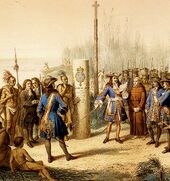 Claiming Louisiana for France in 1682
Claiming Louisiana for France in 1682
- 1678 نشبت الحرب بين الدولة العثمانية وروسيا بسبب الصراع حول الأراضي الأوروبية الشرقية في أوكرانيا.
- 1680 أصدر كارل الحادي عشر ملك السويد قانون الانتزاع السويدي لاستعادة كل الهبات التي منحت للنبلاء لاحياء الاقتصاد السويدي.
- 1681 أنتهت الحملة العثمانية علي روسيا بعقد معاهدة أدرنة بين الدولتين أتفق فيها الطرفان على تقسيم أوكرانيا بين العثمانيين والروس.
- 1682 وفاة قيصر روسيا فيودر الثالث في مايو وخلفه اخيه إيفان الخامس مشاركة مع اخيه بطرس نظرا لمرضه .
- 1683 حاصر الجيش العثماني العاصمة النمساوية فيينا لمدة شهرين فأستغاث الامبراطور الروماني ليوبولد الأول بالإمارات الألمانية ولكنها تباطأت فارسل ل يوحنا الثالث سوبياسكي ملك بولندا الذي اتي بالامدادات وأنتصر علي العثمانيين في معركة فيينا واجبرهم علي فك الحصار عن فيينا.
- 1684 شكلت النمسا وبولندا وجمهورية البندقية تحالف مقدس لمحاربة العثمانيين.
- 1685 وفاة تشارلز الثاني ملك إنجلترا وايرلندا واسكتلندا في فبراير وخلفه اخيه جيمس الثاني ملك إنجلترا .
- 1687 تلقى العثمانيين هزيمة منكرة في معركة موهاج الثانية أمام التحالف المقدس وسقطت بودا العاصمة القديمة للمجر واستولي البنادقة علي بلاد المورة.
- 1687 ثار الجيش العثماني بسبب الهزائم المتتابعة التي لحقت بالدولة العثمانية وقام بخلع السلطان محمد الرابع في نوفمبر وخلفه اخيه سليمان الثاني وفي بداية عهده سقطت بلغراد وترانسلفانيا والبوسنة والأفلاق في أيدي الحلف المقدس بقيادة النمسا.
- 1687 خشي لويس الرابع عشر ملك فرنسا من انتصارات الحلف المقدس فنقض الهدنة مع الامبراطورية الرومانية وتجددت الحرب بين فرنسا والجيش الامبراطوري فتوقف الزحف علي الدولة العثمانية.
- 1688 ثار البرلمانيون علي جيمس الثاني ملك إنجلترا الكاثوليكي وعزلوه وتتويج ابنته ماري الثانية ملكة إنجلترا وزوجها ويليام الثالث ملك إنجلترا.
- 1690 عين السلطان العثماني سليمان الثاني مصطفي كوبريللي صدر اعظم الذي انتصر في معركتي كلادوفا واورسوفا بالبوسنة واستعاد بلغراد وبذلك استعادوا نهر الدانوب كخط حدودي وحاول إعادة احتلال المجر لكنه هـُزم في معركة سلانكامن على يد الجيش النمساوي.
- 1691 وفاة السلطان العثماني سليمان الثاني في يونيو وخلفه اخيه أحمد الثاني.
- 1695 وفاة السلطان العثماني أحمد الثاني في فبراير وخلفه ابن اخيه مصطفى الثاني.
- 1696 وفاه قيصر عموم روسيا إيفان الخامس في يناير وخلفه اخيه بطرس الأكبر الذي قاد سياسة التوسع التي حولت روسيا القيصرية إلى الإمبراطورية الروسية.
- 1696 وفاة الملك البولندي يوحنا الثالث سوبياسكي وانتخب الديت خلفه ناخب ساكسونيا فريدرش أوغسطس الأول.
- 1697 وفاة كارل الحادي عشر ملك السويد في ابريل وخلفه ابنه كارل الثاني عشر.
- 1699 تمكن الحلف المقدس من تحقيق الانتصار علي الجيش العثماني وأجبر السلطان العثماني مصطفى الثاني على توقيع معاهدة كارلوفجة تنازل فيها عن معظم أراضي المجر وترانسلفانيا وسلافونيا للنمسا في حين عادت بودوليا إلى بولندا ودالاماتيا وبلاد المورة لجمهورية البندقية.
- 1697–1699: Grand Embassy of Peter the Great to Western Europe.
- 1699: Thomas Savery demonstrates his first steam engine to the Royal Society.
معرض
Catholic general Albrecht von Wallenstein (1583–1634), supreme commander of the armies of the Imperial Army during the Thirty Years War
Jan Pieterszoon Coen (1587–1629), the founder of Batavia, was an officer of the Dutch East India Company (VOC), holding two terms as its Governor-General of the Dutch East Indies
René Descartes (1596–1650) with Queen Christina of Sweden (1626–1689)
Cardinal Mazarin (1602–1661), who served as the chief minister to the kings of France Louis XIII and Louis XIV
Mughal Emperor Aurangzeb (1618–1707), who ruled over almost the entire Indian subcontinent for a period of 49 years
Chhatrapati Shivaji (1630–1680) founder of Maratha Empire is widely regarded as one of the greatest Hindu ruler
Shōgun Tokugawa Ieyasu was the founder of Japan's final shogunate, which lasted well into the 19th century
الاختراعات والاكتشافات والتقديمات
Major changes in philosophy and science take place, often characterized as the Scientific revolution.
- Banknotes reintroduced in Europe.
- Ice cream.
- Tea and coffee become popular in Europe.
- Central Banking in France and modern Finance by Scottish economist John Law.
- Minarets, Jamé Mosque of Isfahan, Isfahan, Persia (Iran), are built.
- 1604: Supernova SN 1604 is observed in the Milky Way.
- 1605: Johannes Kepler starts investigating elliptical orbits of planets.
- 1605: Johann Carolus of Germany publishes the 'Relation', the first newspaper.
- 1608: Refracting telescopes first appear. Dutch spectacle-maker Hans Lippershey tries to obtain a patent on one, spreading word of the invention.
- 1610: The Orion Nebula is identified by Nicolas-Claude Fabri de Peiresc of France.
- 1610: Galileo Galilei and Simon Marius observe Jupiter's Galilean moons.
- 1611: King James Bible or 'Authorized Version' first published.
- 1612: The first flintlock musket likely created for Louis XIII of France by gunsmith Marin Bourgeois.
- 1614: John Napier introduces the logarithm to simplify calculations.
- 1616: Niccolò Zucchi describes experiments with a bronze parabolic mirror trying to make a reflecting telescope.
- 1620: Cornelis Drebbel, funded by James I of England, builds the first 'submarine' made of wood and greased leather.
- 1623: The first English dictionary, 'English Dictionarie' is published by Henry Cockeram, listing difficult words with definitions.
- 1628: William Harvey publishes and elucidates his earlier discovery of the circulatory system.
- 1637: Dutch Bible published.
- 1637: Teatro San Cassiano, the first public opera house, opened in Venice.
- 1637: Pierre de Fermat formulates his so-called Last Theorem, unsolved until 1995.
- 1637: Although Chinese naval mines were earlier described in the 14th century Huolongjing, the Tian Gong Kai Wu book of Ming dynasty scholar Song Yingxing describes naval mines wrapped in a lacquer bag and ignited by an ambusher pulling a rip cord on the nearby shore that triggers a steel-wheel flint mechanism.
- 1642: Blaise Pascal invents the mechanical calculator called Pascal's calculator.
- 1642: Mezzotint engraving introduces grey tones to printed images.
- 1643: Evangelista Torricelli of Italy invents the mercury barometer.
- 1645: Giacomo Torelli of Venice, Italy invents the first rotating stage.
- 1651: Giovanni Riccioli renames the lunar maria.
- 1656: Christiaan Huygens describes the true shape of the rings of Saturn.
- 1657: Christiaan Huygens develops the first functional pendulum clock based on the learnings of Galileo Galilei.
- 1659: Christiaan Huygens first to observe surface details of Mars.
- 1662: Christopher Merret presents first paper on the production of sparkling wine.
- 1663: James Gregory publishes designs for a reflecting telescope.
- 1669: The first known operational reflecting telescope is built by Isaac Newton.
- 1676: Antonie van Leeuwenhoek discovers Bacteria.
- 1676: First measurement of the speed of light.
- 1679: Binary system developed by Gottfried Wilhelm Leibniz.
- 1684: Calculus independently developed by both Gottfried Wilhelm Leibniz and Sir Isaac Newton and used to formulate classical mechanics.
شخصيات هامة
- غوستافوس أدولفوس، ملك السويد (1594 - 1632).
- توكوجاوا إيياسو.
- فرانسيز بيكون، فيلسوف وسياسي إنجليزي (1561 - 1626).
- غابريل بيثلين، أمير المجر (1580 - 1629).
- السير توماس براون، مؤلف إنجليزي وفيلسوف وعالم (1605 - 1682).
- تشارلز الأول من إنجلترا (1600 - 1649).
- تشارلز الثاني من إنجلترا (1630 - 1685).
- جون دون، شاعر إنجليزي (1572 - 1631).
- إليزابيث الأولى من إنجلترا (1533 - 1603).
- غاليلو غاليلي، فيلسوف طبيعي إيطالي (1564 - 1642).
- أندريس جريفيوس، شاعر ومسرحي ألماني (1616 - 1664).
- توماس هوبز، فيلسوف وعالم رياضيات إنجليزي (1588 - 1679).
- يوهانز كيبلير، فلكي ألماني (1571 - 1630).
- جون لوك، فيلسوف إنجليزي (1632 - 1704).
- جيمس الأول من إنجلترا (1566 - 1625).
- جيمس الثاني من إنجلترا (1633 - 1701).
- ليوبولد الأول، إمبراطور روماني مقدس (1640 - 1705).
- لويس الرابع عشر، ملك فرنسا (1638 - 1715).
- ماري الثانية من إنجلترا (1662 - 1694).
- جون ميلتن، مؤلف وشاعر إنجليزي (1608 - 1674).
- مياموتو موساشي، محارب مشهور في اليابان، ومؤلف كتاب "خمسة الحلقات"، إطروحة في الإستراتيجية والمعركة العسكرية (1584 - 1645).
- إسحاق نيوتن، فيزيائي وعالم رياضيات إنجليزي (1642 - 1727).
- صموئيل بيبس، موظف حكومي وكاتب يوميات إنجليزي (1633 - 1703).
- هنري بورسيل، ملحن إنجليزي (1659 - 1695).
- سامارث رامداس، قديس هندوسي (1608 - 1681).
- وليام شيكسبير، مؤلف وشاعر إنجليزي (1564 - 1616).
- وليام الثالث من إنجلترا (1650 - 1702).
معرض صور
Catholic general Albrecht von Wallenstein (1583–1634), supreme commander of the armies of the Imperial Army during the Thirty Years War
Jan Pieterszoon Coen (1587–1629), the founder of Batavia, was an officer of the Dutch East India Company (VOC), holding two terms as its Governor-General of the Dutch East Indies
René Descartes (1596–1650) with Queen Christina of Sweden (1626–1689)
Cardinal Mazarin (1602–1661), who served as the chief minister to the kings of France Louis XIII and Louis XIV
Mughal Emperor Aurangzeb (1618–1707), who ruled over almost the entire Indian subcontinent for a period of 49 years
Chhatrapati Shivaji (1630–1680) founder of Maratha Empire is widely regarded as one of the greatest Hindu ruler
Shōgun Tokugawa Ieyasu was the founder of Japan's final shogunate, which lasted well into the 19th century
المراجع
- ^ أ ب "The Thirty-Years-War". Western New England College. Archived from the original on 1999-10-09. Retrieved 2008-05-24. خطأ استشهاد: وسم
<ref>غير صالح؛ الاسم "TYW-WNEC" معرف أكثر من مرة بمحتويات مختلفة. - ^ "The Seventeenth-Century Decline". The Library of Iberian resources online. Retrieved 13 August 2008.
- ^
{{cite web}}: Empty citation (help) - ^ "The Seventeenth-Century Decline". The Library of Iberian resources online. Retrieved 13 August 2008.
- ^ Maddison, Angus (2003): Development Centre Studies The World Economy Historical Statistics: Historical Statistics, OECD Publishing, ISBN 9264104143, pages 259–261
- ^ "The Tatar Khanate of Crimea". Archived from the original on 2016-03-23. Retrieved 2008-06-05.
- ^ أ ب ت "Sambhaji..." BYJU'S.
- ^ "London museum correct record on general disembowelment by Chhatrapati Shivaji". The Tribune.
للاستزادة
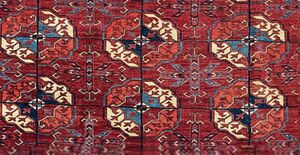
- Chang, Chun-shu, and Shelley Hsueh-lun Chang. Crisis and Transformation in Seventeenth-Century China" (1998).
- Langer, William. An Encyclopedia of World History (5th ed. 1973); highly detailed outline of events online free
- Reid, A. J. S. Trade and State Power in 16th & 17th Century Southeast Asia (1977).
- Spence, J. D. The Death of Woman Wang: Rural Life in China in the 17th Century (1978).
Focus on Europe
- Clark, George. The Seventeenth Century (2nd ed. 1945).
- Hampshire, Stuart. The Age of Reason the 17th Century Philosophers, Selected, with Introduction and Interpretive Commentary (1961).
- Hugon, Cécile (1997) [1911]. "Social Conditions in 17th-Century France (1649-1652)". In Halsall, Paul (ed.). Social France in the XVII Century. London: Methuen. pp. 171–172, 189. ISBN 9780548161944. Archived from the original on 23 August 2016. Retrieved 7 August 2021.
- Lewitter, Lucian Ryszard. "Poland, the Ukraine and Russia in the 17th Century." The Slavonic and East European Review (1948): 157–171. in JSTOR
- Ogg, David. Europe in the Seventeenth Century (6th ed. 1965).
- Rowbotham, Sheila. Hidden from history: Rediscovering women in history from the 17th century to the present (1976).
- Trevor-Roper, Hugh R. "The general crisis of the 17th century." Past & Present 16 (1959): 31–64.
وصلات خارجية
- Vistorica: Timelines of 17th century events, science, culture and persons

